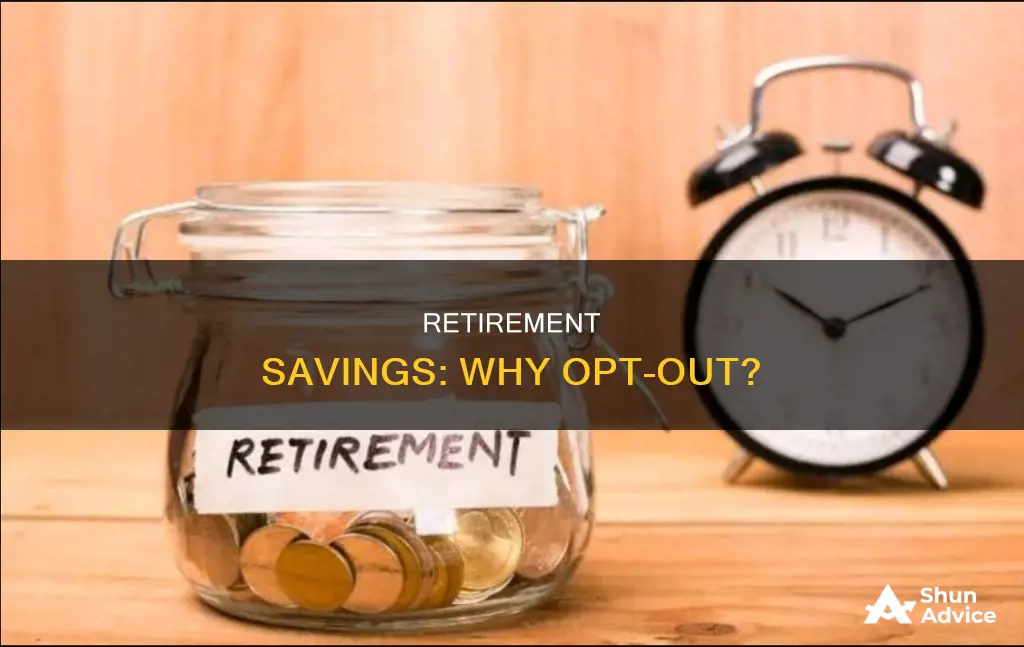
There are several reasons why people may choose not to invest in 401(k)s. Firstly, 401(k)s often come with high fees and poor investment options, including expensive mutual funds with high expense ratios. Additionally, 401(k)s may not be a good choice for those planning to retire early, as most plans prohibit withdrawals before the age of 59 1/2 without penalties. Furthermore, the investment options offered by 401(k) plans may be limited and of low quality, especially for participants in small retirement plans. Another reason people may avoid 401(k)s is the complex tax implications, as withdrawals are taxed at the personal income tax level, which may be higher than the capital gains tax rate. Lastly, some self-made millionaires argue that instead of saving, one should focus on earning and investing in other opportunities.
| Characteristics | Values |
|---|---|
| Lack of employer match | No incentive to invest |
| High fees | Expensive |
| Early retirement | Inaccessible |
| Lack of investment options | Lack of control |
| Complex tax implications | Taxed at a higher rate |
| Lack of liquidity | Inaccessible |

High fees
There are three basic categories of 401(k) fees: investment fees, plan administration fees, and individual service fees. Investment fees, which are often the largest, are charged as a percentage of assets invested and can include sales loads, expense ratios, and other costs. For example, a 1% fee will charge you 1% of your current assets in that fund every year. Front-end loads are commissions paid to brokers who sign up clients, while purchase fees are charged by mutual funds when buying shares. Back-end loads are fees charged when selling shares in a fund. 12b-1 fees, or level-load fees, are ongoing charges for marketing and servicing the fund, capped at 1%. Investment management fees cover the fund's expenses, from office space to salaries.
Plan administration fees are charged by the 401(k) provider and cover services such as legal, trustee, record-keeping, and accounting. They also include day-to-day operations like customer service and electronic access to plan information. These fees are usually passed on to the employee as a flat fee or a percentage of assets invested.
Individual service fees are for extra plan features that participants opt into, such as distribution services, rolling over 401(k) investments, taking out loans, and QDROs (dividing assets during divorce).
The average 401(k) expense ratio is 1%, but it can vary depending on the plan's size and investments offered. The expense ratio is expressed as a percentage of assets, for example, 1% of $100,000 in plan assets is $1,000. These fees are typically paid annually.
To protect yourself from high fees, it's important to understand what you're paying. Review your 401(k) statement and fee disclosure statement, and compare your plan with others of similar size. If your plan's fees are high, consider meeting with your plan administrator to lobby for a better plan with lower fees. You can also select cheaper investment options, such as low-fee funds, or consider investing elsewhere, such as in an IRA.
John Cabot's First Expedition: Investors' Motives
You may want to see also

Poor investment options
The range of investment options available in 401(k) plans is often limited and may not be suitable for everyone. The conventional wisdom in the 401(k) plan investment industry is that "less is more". Typically, a comprehensive retirement plan design offers a group of investment options that cover roughly five asset class categories: money-market funds or stable value funds, large-capitalization funds, mid-capitalization funds, small-capitalization funds, and bond funds.
However, to build a comprehensive portfolio for your long-term financial needs, you will likely also need access to Treasury Inflation-Protected Securities (TIPS) funds, high-yield funds, real estate investment trust (REIT) funds, emerging markets funds, and commodity funds.
The quality of the investment options offered in your plan may be well below average, especially if you are a participant in a small retirement plan. The investment options may be fully valued or even overvalued at the time your contributions are made. Additionally, most active mutual funds, on which 401(k) plans are based, do not outperform their index or benchmark, and you would be better off putting your money into an index fund.
If you find yourself in a 401(k) plan with limited or subpar investment choices, you can consider opening a self-directed brokerage account, such as an individual retirement account (IRA), which usually offers a wider range of investment options at a lower cost.
It is also worth noting that the fees associated with 401(k) plans can eat into your investment returns. These fees are determined by the deal your employer made with the financial services company that manages the plan, and they can vary significantly from one plan to another. Actively managed funds, which hire analysts to conduct securities research, tend to have higher management fees. On the other hand, index funds generally have the lowest fees because they require little to no hands-on management by a professional.
Real Estate: Why the Hesitation?
You may want to see also

Debt
Impact of Debt on Investment Decisions
The presence of debt can significantly impact an individual's ability to contribute to their retirement savings. High-interest debt, such as credit card debt, can be particularly detrimental as it may reduce one's disposable income available for investing. It is essential to evaluate the interest rates on your debt and compare them to the expected returns on your 401(k) investments. If the interest rates on your debt are higher than the expected returns, you may want to prioritize paying off the debt before investing heavily in your 401(k).
Strategies for Managing Debt and Investing
- Aggressive Debt Repayment: Some individuals may prefer to pay off all their debt as quickly as possible before saving for retirement. This strategy ensures that debt does not accumulate and compound over time, allowing for a fresh start when focusing on retirement savings.
- Balancing Debt Repayment and Investing: If you have low-interest debt and anticipate higher returns on your 401(k) investments, it may be advisable to contribute to your 401(k) while gradually paying off your debt. Prioritize paying off high-interest debt to minimize the overall financial burden.
- Employer Matching Contributions: If your employer matches your 401(k) contributions, it is generally recommended to contribute enough to receive this benefit, regardless of your debt levels. Failing to do so means missing out on "free money."
Using 401(k) Funds to Pay Off Debt
While it is generally not advisable to withdraw from your 401(k) early to pay off debt, there may be certain circumstances where it could be beneficial. Withdrawing from your 401(k) before the age of 59 1/2 generally incurs income tax and a 10% penalty on the withdrawn amount. However, if you are facing high-interest debt, such as credit card debt, and have no other means to pay it off, using a portion of your 401(k) funds could be an option.
Alternatives to Early 401(k) Withdrawals
Before considering early withdrawals from your 401(k), explore alternative options:
- Negotiate Interest Rates: If you have a good credit history, you may be able to negotiate lower interest rates with your credit card company.
- Balance Transfer Credit Cards: Transferring credit card balances to lower-interest cards or those with promotional 0% interest rates can provide temporary relief.
- Debt Consolidation: If your credit score has improved, consider consolidating private student loans or other debts into a lower-interest loan.
- 401(k) Loans: Some 401(k) plans allow participants to take out loans from their vested balance. These loans typically have a five-year repayment period and do not affect your credit score. However, if you leave your job, the loan must usually be repaid within a shorter timeframe.
Crypto Investors: How Many?
You may want to see also

Lack of employer match
A 401(k) without an employer match refers to a retirement savings plan where employers don't contribute to the employee's account. In a typical 401(k), employers match a portion of their employee's contributions, but in this case, the employee wholly funds the plan. While a 401(k) with an employer match is ideal, a 401(k) without one can still be beneficial.
Advantages
Even without an employer match, a 401(k) offers several advantages:
- Tax benefits: Contributions to a traditional 401(k) are tax-deductible, reducing your current taxable income and overall tax bill. Additionally, investment earnings in a 401(k) are not taxed until withdrawals are made during retirement. This tax-deferred growth allows investments to grow without the drag of taxes, potentially leading to more significant compound growth over time.
- Higher contribution limits: 401(k) plans have higher annual contribution limits compared to alternative plans like IRAs. For 2023, the maximum contribution for individuals under 50 is $22,500, with an additional $6,500 catch-up contribution for those 50 and older. In 2024, the limit increases to $23,000, with the same catch-up amount. In contrast, IRAs have lower contribution limits, such as $6,500 in 2023 and $7,000 in 2024 for individuals under 50.
- Protection from creditors and bankruptcy: Under U.S. federal law, 401(k) assets are generally safeguarded in financial troubles, including bankruptcy. This feature provides a financial safety net and encourages consistent, long-term savings behavior.
- Loan and hardship withdrawals: While not ideal for long-term planning, 401(k) plans allow for loans or hardship withdrawals in emergencies. Loans are subject to certain limits and generally have to be repaid within five years, often with interest paid back into the 401(k) account. Hardship withdrawals are taxed and may incur a 10% early withdrawal penalty if taken before age 59 ½, but they can provide funds for significant expenses like medical costs, buying a home, or education.
- Independence and control: With a 401(k) without an employer match, you have the autonomy to contribute as much as you want (within IRS limits) and choose your investment options. This level of control can be empowering and allows you to tailor your retirement savings plan to your unique needs and goals.
Disadvantages
Despite these advantages, there are also some drawbacks to a 401(k) without an employer match:
- Lack of employer contributions: The most significant disadvantage is missing out on "free money" from employer matching contributions, which can boost your retirement savings over time. Without an employer match, the entire burden of funding the 401(k) rests on the employee.
- Potential for high fees: 401(k) plans often have higher fees than other investment vehicles, and without an employer match to offset these costs, they can eat into your returns. It's important to understand the fee structure and consider this in your planning.
- Difficulty of early access: While early withdrawals are possible, they come with penalties, making it an expensive option. Unless there is a significant financial emergency, it's generally best to leave 401(k) funds untouched until retirement.
In conclusion, while a 401(k) without an employer match may not be ideal, it still offers valuable benefits, especially in tax advantages, higher contribution limits, and independence in managing your retirement savings. However, it's important to be mindful of the potential drawbacks and take a strategic approach to maximize the benefits of this retirement savings tool.
Russia: Invest or Avoid?
You may want to see also

Early retirement plans
Step 1: Adjust Your Current Budget
The first step towards early retirement is to make adjustments to your current budget. This may involve cutting your budget to a minimum and aiming to live on a percentage of your income, with the rest funnelled into savings. It is important to eliminate debt and cut down on expenses, finding creative ways to save money on transportation, utilities, food and housing costs.
Step 2: Calculate Your Annual Retirement Spending
The next step is to calculate your annual retirement spending. Assess your current monthly spending and consider what expenses will go down, go up, or be cut altogether. Add up your final monthly estimates, multiply by 12, and you have your annual retirement needs. It is recommended to increase this figure by 10-20% to allow for some flexibility. Don't forget to factor in taxes and healthcare costs, which can be a significant expense, especially if you are leaving an employer-provided health insurance plan.
Step 3: Estimate Your Total Savings Needs
A widely used rule of thumb for early retirees is the "rule of 25": you should have 25 times your planned annual spending saved before retiring. For example, if you plan to spend $50,000 in your first year of retirement, you should have $1,250,000 invested. This rule assumes that your savings will continue to grow to keep up with inflation.
Step 4: Invest for Growth
To achieve a successful early retirement, investment returns are crucial. Consider investing in a balanced portfolio geared towards long-term growth, using low-cost index funds with an allocation tilted towards stocks. It is important to remember that your investment horizon includes the time you spend in retirement, so your money needs to continue growing during that period too. As you approach your planned retirement date, consider shifting a small amount of your savings into safer, more liquid assets.
Step 5: Keep Your Expenses in Check
Sticking to your retirement budget is crucial. It is easy to let expenses creep up, especially when you have more time on your hands for vacations, hobbies, or other pursuits. The "4% rule" is a guideline that suggests you can withdraw 4% of your invested savings during your first year of retirement, then adjust for inflation in subsequent years. Deviating from this rule by increasing your spending increases your risk of running out of money.
Early Retirement and 401(k)s
While a 401(k) can be a powerful tool for retirement savings, some people choose not to invest in them. Self-made millionaire Grant Cardone, for example, argues that 401(k)s are "traps that prevent people from ever having enough". Instead, he recommends focusing on earning and saving money in a traditional savings account until you have a substantial sum to invest.
However, it is important to note that not investing in a 401(k) means missing out on high contribution limits and employer matches that can boost your savings. There are also tax implications to consider, as withdrawing from retirement accounts before the age of 59.5 typically incurs additional taxes and penalties. If you are planning for early retirement, careful financial planning and consultation with a professional advisor are essential to ensure you have sufficient funds to last through your retired years.
Millionaires' Investment Strategies
You may want to see also
Frequently asked questions
Some people choose not to invest in a 401k because of high fees, poor investment options, or a lack of matching contributions from their employer. Others may have more pressing financial concerns, such as debt, or are worried about the long-term tax implications of a 401k.
401ks often have limited investment options and can come with unnecessary fees. They may also negatively impact your tax status in retirement, especially if you are in a higher tax bracket or have other sources of retirement income.
An Individual Retirement Account (IRA) offers greater variety in investment options and lower fees. However, a 401k still has advantages, such as higher contribution limits and the potential for employer-matching funds.
It depends on your financial situation and goals. If you are offered a 401k with employer-matching contributions, it is generally advisable to contribute at least enough to get the full match. After that, you may want to consider investing in an IRA or other accounts to diversify your retirement savings.







